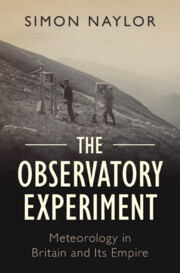Refine search
Actions for selected content:
10306 results in History of science: general interest
Thomas B. Robertson and Jenny Leigh Smith (eds.), Transplanting Modernity: The Environmental Legacy of International Development Pittsburgh: University of Pittsburgh Press, 2023. Pp. 320. ISBN 978-0-8229-4639-7. $50.00 (hardcover).
-
- Journal:
- The British Journal for the History of Science / Volume 58 / Issue 1 / March 2025
- Published online by Cambridge University Press:
- 18 October 2024, pp. 175-176
- Print publication:
- March 2025
-
- Article
- Export citation
Value, knowledge and reputation: zoological exchange by Australian museums, 1870–1900
-
- Journal:
- The British Journal for the History of Science / Volume 58 / Issue 1 / March 2025
- Published online by Cambridge University Press:
- 18 October 2024, pp. 81-100
- Print publication:
- March 2025
-
- Article
-
- You have access
- Open access
- HTML
- Export citation
Conclusion: Historical Geographies of Future Weather
-
- Book:
- The Observatory Experiment
- Published online:
- 05 October 2024
- Print publication:
- 10 October 2024, pp 235-246
-
- Chapter
- Export citation
Contents
-
- Book:
- The Observatory Experiment
- Published online:
- 05 October 2024
- Print publication:
- 10 October 2024, pp v-v
-
- Chapter
- Export citation
Copyright page
-
- Book:
- The Observatory Experiment
- Published online:
- 05 October 2024
- Print publication:
- 10 October 2024, pp iv-iv
-
- Chapter
- Export citation
Index
-
- Book:
- The Observatory Experiment
- Published online:
- 05 October 2024
- Print publication:
- 10 October 2024, pp 268-276
-
- Chapter
- Export citation
1 - Meteorology All at Sea
-
- Book:
- The Observatory Experiment
- Published online:
- 05 October 2024
- Print publication:
- 10 October 2024, pp 22-65
-
- Chapter
- Export citation
4 - Geographies of the Rain
-
- Book:
- The Observatory Experiment
- Published online:
- 05 October 2024
- Print publication:
- 10 October 2024, pp 168-234
-
- Chapter
- Export citation
Introduction: Observatory Experiments
-
- Book:
- The Observatory Experiment
- Published online:
- 05 October 2024
- Print publication:
- 10 October 2024, pp 1-21
-
- Chapter
- Export citation
2 - Meteorology at the Colonial Observatories
-
- Book:
- The Observatory Experiment
- Published online:
- 05 October 2024
- Print publication:
- 10 October 2024, pp 66-109
-
- Chapter
- Export citation
Acknowledgements
-
- Book:
- The Observatory Experiment
- Published online:
- 05 October 2024
- Print publication:
- 10 October 2024, pp viii-x
-
- Chapter
- Export citation
3 - Mountain Meteorology on Ben Nevis
-
- Book:
- The Observatory Experiment
- Published online:
- 05 October 2024
- Print publication:
- 10 October 2024, pp 110-167
-
- Chapter
- Export citation
Bibliography
-
- Book:
- The Observatory Experiment
- Published online:
- 05 October 2024
- Print publication:
- 10 October 2024, pp 247-267
-
- Chapter
- Export citation
Figures
-
- Book:
- The Observatory Experiment
- Published online:
- 05 October 2024
- Print publication:
- 10 October 2024, pp vi-vii
-
- Chapter
- Export citation

The Observatory Experiment
- Meteorology in Britain and Its Empire
-
- Published online:
- 05 October 2024
- Print publication:
- 10 October 2024
Innovation amidst post-socialist reform: Jonas Salk and the birth of the Sabin strains-derived inactivated polio vaccine in China
-
- Journal:
- The British Journal for the History of Science / Volume 57 / Issue 3 / September 2024
- Published online by Cambridge University Press:
- 04 February 2025, pp. 407-423
- Print publication:
- September 2024
-
- Article
- Export citation
When Scottish medicine hospitalized Indian magic: Dr James Esdaile's mesmeric surgery in mid-nineteenth-century Bengal
-
- Journal:
- The British Journal for the History of Science / Volume 57 / Issue 3 / September 2024
- Published online by Cambridge University Press:
- 16 December 2024, pp. 325-347
- Print publication:
- September 2024
-
- Article
- Export citation
BJH volume 57 issue 3 Cover and Back matter
-
- Journal:
- The British Journal for the History of Science / Volume 57 / Issue 3 / September 2024
- Published online by Cambridge University Press:
- 25 March 2025, pp. b1-b4
- Print publication:
- September 2024
-
- Article
-
- You have access
- Export citation
Paulo Galluzzi, The Italian Renaissance of Machines Cambridge, MA: Harvard University Press, 2020. Pp. 296. ISBN 978-0-674-98439-4. £37.95 (hardcover). – ERRATUM
-
- Journal:
- The British Journal for the History of Science / Volume 57 / Issue 3 / September 2024
- Published online by Cambridge University Press:
- 21 January 2025, p. 519
- Print publication:
- September 2024
-
- Article
-
- You have access
- HTML
- Export citation
BJH volume 57 issue 3 Cover and Front matter
-
- Journal:
- The British Journal for the History of Science / Volume 57 / Issue 3 / September 2024
- Published online by Cambridge University Press:
- 25 March 2025, pp. f1-f2
- Print publication:
- September 2024
-
- Article
-
- You have access
- Export citation
